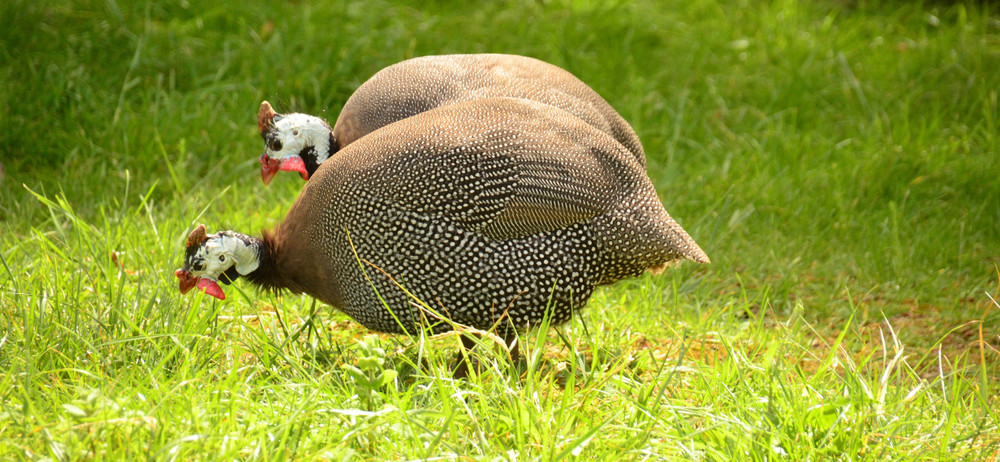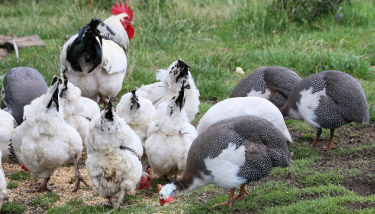Free ranging your Guinea fowl.

Guineas are quite similar to turkeys in their habits and have never become fully domesticated. They are impatient birds especially if kept indoors preferring to roost out in the open, though they will frequently roost in the hen-house with the chickens.
If you plan to free range your guinea fowl you can use the feed and water to help bring them back every night bu making sure the supply of feed and clean fresh water is in the run.
Below: My Guinea fowl free ranging with the Light Sussex hens.

They are very hardy and usually necessitate little care and they are well amused by open spaces. A mirror or reflective surface is excellent for guineas, they like to look at themselves.
Because of their watchful alertness and their loud warning cries in the presence of danger, they are frequently kept on farms to warn the other fowls of danger and to frighten away hawks, crows, and the like.
Guineas are not recognised as a standard class of poultry and you wont see them at poultry shows.
At what age do you let Guinea fowl free range?
Me, personally, never before 12 weeks of age. They are just too young and flighty and need to settle into their new surroundings well before you let them out. My answer is that you can start to free range guinea fowl from between 3 and 4 months of age.
The first stage is to let them out just 30 minutes or so before they normally roost, that way they won't have the time to wander far before it'd bedtime.
Management of Guinea Fowl:
It is a good job they spend so much time free ranging as they make a peculiar, harsh, querulous noise, which is oft-repeated, and not agreeable. It is loud and ongoing.
Young birds will do extremely well on a regime designed for turkeys, but generally, they can be fed a diet similar to that suggested for chickens and bantams.
Ranging Guinea fowl will find a great deal of their food naturally and they are more interested in insects and bugs than they are in most things vegetable, although they do graze, makes them better for the backyard keeper who may be worried about his prize vegetable plot.
Unlike other types of poultry, which have separate breeds, Guinea fowl merely have differing colours. There is the normal coloured plumage - grey on the neck with white spotted feathers on the body, called pearl.
There is about two dozen different but not all really distinctive colours, ranging from chocolate and pewter to purple and lavender, but some specific colours are given names such as White, Lavender, Buff Dundottes and Royal Blue.
My Guinea fowls are all free range and spend their day in 4 acres of North Yorkshire. They eat exactly the same feed as the chickens get and they seem to ignore the layers pellets entirely. My birds have an all seed scratch that includes 4% sunflowers seeds 4% safflower seed, wheat, cracked maize and millet.
What do Guinea fowl do all day?
They graze all day but tend to have a big feed first thing in the morning and last thing before bed. I sometimes never see them all day. You always hear them though.
Guineas need to consume some greens in order to maintain good digestion, and so they eat sprouts, grass, dandelions, weeds, and other vegetation. It is a wandering bird requiring an extensive range and it finds nearly all of its food, especially in the summer months when there is plenty of insect life about.
Guineas need the same Grit with shell and fresh water all poultry does
A mirror will give both you and the Guinea fowl hours of endless fun.
Guineas are certainly a low maintenance poultry and will happily look after themselves to a greater degree than chickens or ducks.
They tend to elicit a love or hate reaction in people and are seen as funny and fascinating or noisy and disruptive.
They are of course all of these things but I love mine and would never be without them.
Guinea fowl are easy to keep if you have the space and understanding neighbours.
